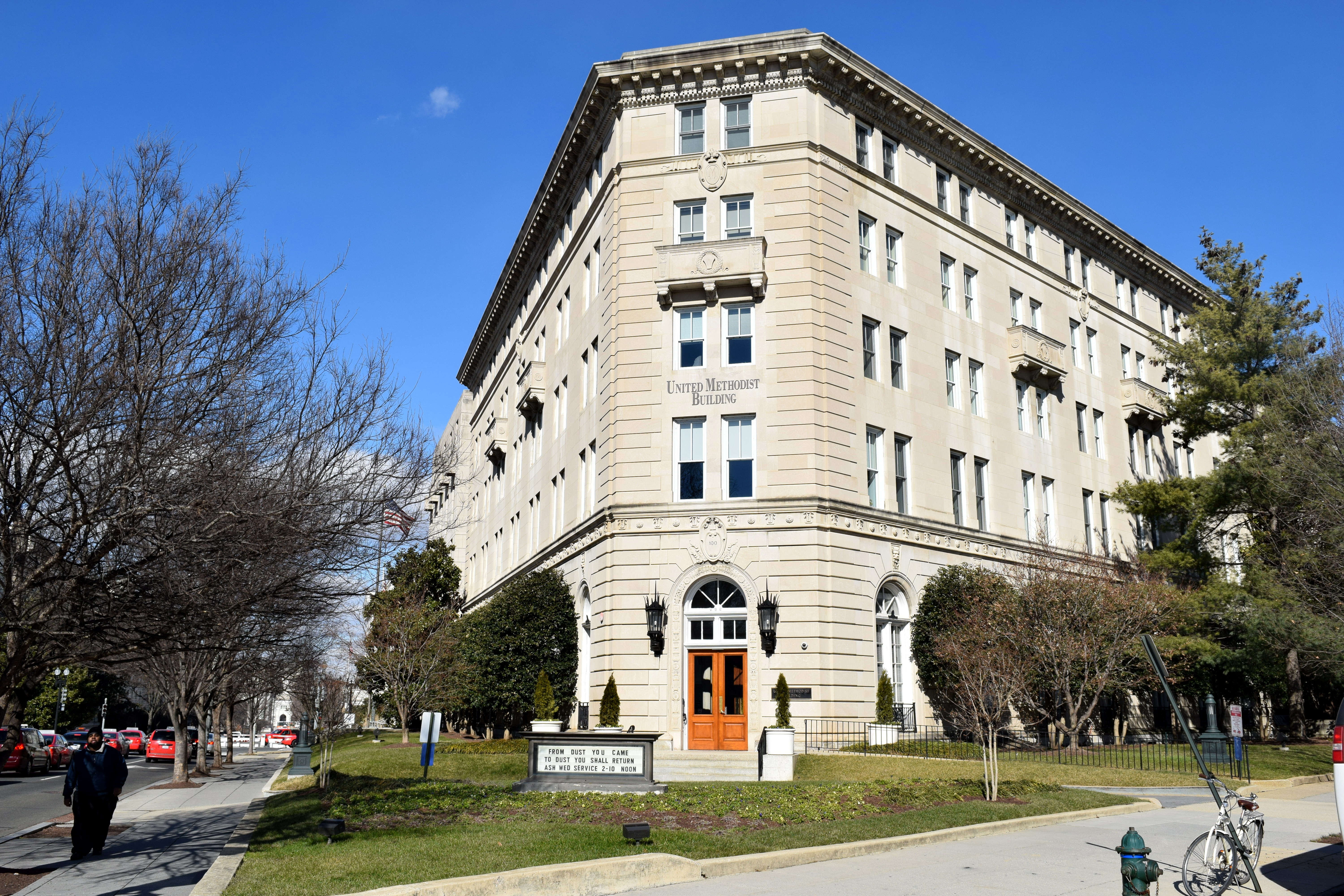The United Methodist Building
Erected in 1923, the United Methodist Building has been a center for faithful advocacy for over one hundred years
- Overview
- The United Methodist Church
- Social Principles as Adopted by General Conference Charlotte, 2024
- Board of Directors
- Resolutions Adopted by General Conference Charlotte
- Meet the Staff
- Annual Conference Connections
- The United Methodist Building
- Careers and Internships
- Partnerships
- Justice Takes Courage Podcast
- Contact Us
- GBCS 2025 Year-End Report

Washington D.C. sits on the ancestral lands of the Anacostans (also documented as Nacotchtank), and over time neighboring the Piscataway and Pamunkey peoples. “Indigenous Tribes of Washington, D.C.”, American Library Association, April 17, 2019.
The United Methodist Building is surrounded by just over a dozen tribal nations that thrive along the Anacostia and Potomac River watersheds, Chesapeake Bay area, and the states of Maryland, Virginia, and Delaware.
A peace garden sits on the south side of the building including a Tree of Peace in honor of former GBCS General Secretary and member of the Seneca Confederacy Dr. Thom White Wolf Fassett. Also in the peace garden is a a peace pole, and a bench for reflection. To support environmental protections in the Anacostia watershed in which the building resides, a green roof was installed in 2010.

The General Board of Church and Society is the proprietor of the United Methodist Building on Capitol Hill in Washington, D.C., where GBCS’ offices are headquartered. The structure is adjacent to the U.S. Capitol and the Supreme Court.
As a public witness to justice and peace, the United Methodist Building offers an ecumenical and interfaith setting for rich dialogue and social action. It houses the Washington offices of a number of ecumenical groups: the Presbyterian Church (USA), the United Church of Christ, Lutheran Services of America, Church World Service, Islamic Society of North America and a host of others. It also houses offices of the United Methodist Council of Bishops, and the United Methodist Commission on Religion and Race.
By action of the 2016 General Conference, the United Methodist Building is designated a United Methodist Church Heritage Landmark, indicating unique historical value in the denomination’s history.
Church and Society also maintains an office in the Church Center for the United Nations in New York City, New York.
Experience the United Methodist Building

We invite you to engage in a virtual online tour of the building to learn about its history and hear from a variety of perspectives about the significance of the building both past and present. Take the Online Tour

We also invite you to consider booking an in-person tour of the building. Tours are about 25 minutes in length and are reserved in 30-minute increments. The majority of the tour takes place on the first floor of the building.
The building is available for tours Mon.- Friday, 9:30 a.m.- 12:00 p.m. and 1:00-4:30 p.m. with the last tour available at 4:30 p.m. The building is not open on the weekends or on Federal holidays. We do not accept walk-in’s for a tour.
For more information about booking an in-person tour, email umbevents@umcjustice.org.
Simpson Memorial Chapel
The United Methodist Building houses the Simpson Memorial Chapel. For more information about the chapel, click here.
United Methodist Building History
In 1917, The Rev. Dr. Clarence True Wilson spotted a muddy, billboard-cluttered corner lot, across the street from the United States Capitol. Immediately, Dr. Wilson, executive director of the Board of Temperance and Public Morals, envisioned this site as the perfect location to establish Methodism’s social reform presence in Washington, D.C.
Construction began on Nov. 17, 1922. A five-story edifice, designed in Italian Renaissance style and constructed of Indiana limestone, it was completed in 1923 at a cost of $650,000. Money for the project was raised through individual and church gifts, some as small as 15 cents. Most of the pledges came from Methodist women concerned about the health of families and the harms of alcohol abuse. Wilson’s wife, Maude Akin Wilson, drew the original plans, which were approved by the board and given to the architect for development. She served as financial officer, property manager and director of operations.
In 1931 a second building was completed at 110 Maryland Avenue with rental income from its fifty apartments expanding the social witness and work of the church.
The United Methodist Building has played a significant role at critical points in United States’ history. Planning for the 1963 March on Washington led by Dr. Martin Luther King Jr. took place here, as well as organizing efforts for the 1968 Poor People’s March, the farmworkers’ boycott, years of protest against the Vietnam War, Equal Rights Amendment marches, the 1978 Long Walk of Native Americans, the 1978 and 1979 Farmer’s Tractorcade, and the 1989 Housing NOW! March, and the 1996 Stand for Children March that included almost every bishop in the denomination. Church and Society partnered to mobilize support for the Americans with Disabilities Act, passed in July 1990.
In 2002-2003 Church and Society served as host to a coalition of groups working to prevent the U.S. invasion of Iraq. And during the Obama administration Church and Society was heavily involved in a faith coalition supporting the Affordable Care Act.
Rent Building Conference Rooms - Rates and Rental Information
Five conference room options are available for rental in the United Methodist Building. View our rental request page for more information.
- Overview
- The United Methodist Church
- Social Principles as Adopted by General Conference Charlotte, 2024
- Board of Directors
- Resolutions Adopted by General Conference Charlotte
- Meet the Staff
- Annual Conference Connections
- The United Methodist Building
- Careers and Internships
- Partnerships
- Justice Takes Courage Podcast
- Contact Us
- GBCS 2025 Year-End Report